Blonde Italian film actress Mariella Lotti (1919–2006) played leading ladies in a number of Fascist-era and post-war films. The refined beauty quickly became one of the most popular Italian divas of the 1940s.
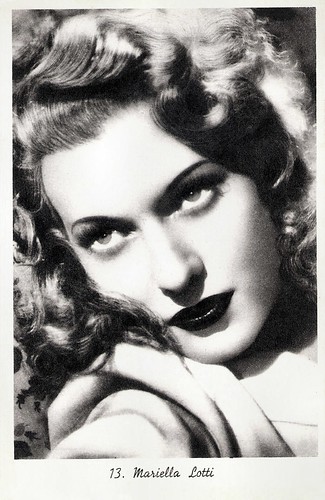
Italian postcard, no. 13.

Italian postcard by A. Terzoli, Roma, no. 420. Photo: Ghergo.

Italian postcard by Alterocca, Terni, no. 6616. Photo: Ferri. Mariella Lotti and Massimo Serato in L'Ispettore Vargas/Inspector Vargas (Gianni Franciolini, Félix Aguilera, 1940).

Italian postcard by Alterocca, Terni, no. 6619. Photo: Ferri / Generalcine. Publicity still for Il fiore sotto gli occhi/The flower under the eyes (Guido Brignone, 1944).
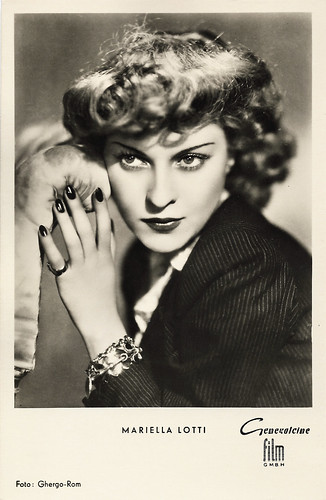
German postcard by Kunst und Bild, Berlin, no. A 570. Photo: Ghergo, Rome / Generalcine Film. Mariella Lotti in La donna che inventò l'amore/The Woman Who Invented Love (Ferruccio Cerio, 1952).
Mariella Lotti was born Maria Camilla Pianotti in 1919 in Busto Arsizio, Lombardy, Italy (on 17 November 1919 according to her baptism certificate or on 18 November 1919 according to her birth certificate) Her sister Carola Lotti later also would be an actress.
In 1939, Mariella made her film debut with a small part in the comedy I figli del marchese Lucera/The sons of the Marquis Lucera (Amleto Palermi, 1939) with Armando Falconi. The following year, she played an important part in the adventure film La figlia del corsaro verde/The Daughter of the Green Pirate (Enrico Guazzoni, 1940), starring Doris Duranti, Fosco Giachetti and Camillo Pilotto.
She also played a supporting part in Il signore della tavern/The tavern ladies (Amleto Palermi, 1940). That year she also appeared in the dramas Kean (Guido Brignone, 1940) with Rossano Brazzi, and Il ponte dei sospiri/The Bridge of Sighs (Mario Bonnard, 1940) with Paola Barbara.
Two years later Lotti appeared in the drama Fari nella nebbia/Headlights in the Fog (Gianni Franciolini, 1942) starring Fosco Giachetti, Luisa Ferida and Antonio Centa. The film follows the lives of a group of truck drivers. It is considered to be part of the development of Neorealism, which emerged around this time.
Lotti then played the title role in the historical adventure film La Gorgona/The Gorgon (Guido Brignone, 1942) about the young daughter of a heroically killed nobleman in 11th Century Pisa who - as the figurehead virgin - will maintain a lantern to celebrate the men's victorious return after driving out the Saracens who are infesting the Mediterranean.
Other films of the fascist era include Quelli della montagna/Those of the Mountain (Aldo Vergano, 1943) with Amedeo Nazzari, the Opera film Silenzio, si gira!/Silence, film recording! (Carlo Campogalliani, 1943) starring Beniamino Gigli, and the war drama Squadriglia bianca (Ion Sava, 1944) with Claudio Gora.
Lotti was one of the many actors employed on the anthology film I dieci comandamenti/The Ten Commandments (Giorgio Walter Chili, 1946), made following the overthrow of Benito Mussolini. The film was shot in Rome in 1944-1945 during the Republic of Salò (when the country occupied by the Germans). At that time, all cinematic activity was transferred to Venice but many actors and technicians refused to go. This film was specifically produced to provide work for all those who decided to stay in Rome. All personnel for the film was able to obtain a work permit from the Vatican as the film, which was based on the classic Bible story, was produced by PROFIR, a Catholic production house closely linked with the catholic church. The film is now considered lost.
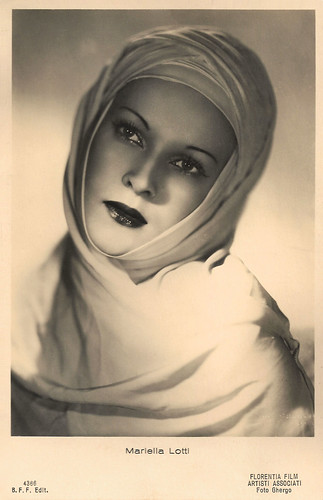
Italian postcard by B.F.F. Edit. (Casa Editr. Ballerini & Fratini, Firenze), no. 4365. Photo: Ghergo / Florentia Film Artisti Associati. Mariella Lotti in La Gorgona/The Gorgon (Guido Brignone, 1942).
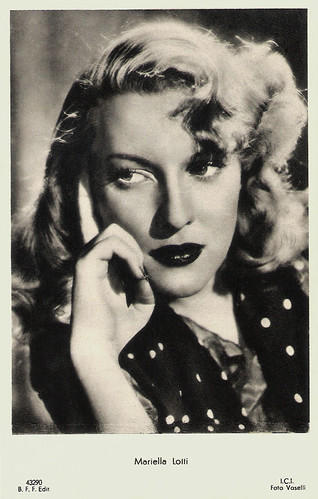
Italian postcard by B.F.F. Edit, no. 43290. Photo: I.C.I. / Vaselli. Publicity still for Fari nella nebbia/Headlights in the fog (Gianni Franciolini, 1942).
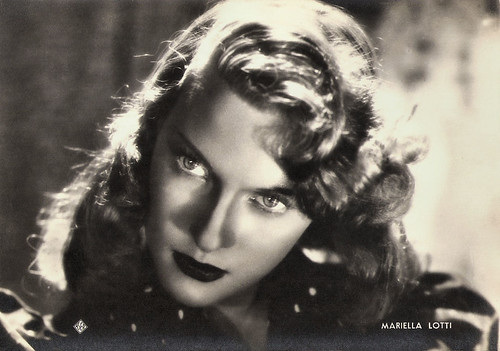
Italian postcard by A. Scarmiglia Ed., Roma (ASER), no. 122. Photo: Fauno Film / Vaselli. Publicity still for Fari nella nebbia/Headlights in the fog (Gianni Franciolini, 1941).

Italian postcard by ASER, no. 20. Sent by mail in 1942.

Italian postcard by ENIC.
In 1946, Mariella Lotti played a nun in the Neorealist war film Un giorno nella vita/A Day in Life (Alessandro Blasetti, 1946), about a group of partisans seeking refuge in a cloistered convent. The film was entered into the 1946 Cannes Film Festival.
She also played the female lead opposite Otello Toso and Amedeo Nazzari in the drama Malacarne/For the Love of Mariastella (1946), written and directed by Pino Mercanti. Based on a story of the Sicilian writer Giuseppe Zucca, it was mainly shot in the tonnara (tuna fisher village) of Castellammare del Golfo, with some scenes shot in the tonnaras of Scopello and of San Vito Lo Capo. It is considered as a progenitor of Pink Neorealism, the lighter genre which followed Neorealism when Italy’s conditions approved.
Lotti then co-starred with Fosco Giachetti and Andrea Checchi in the drama I fratelli Karamazoff/The Brothers Karamazov (Giacomo Gentilomo, 1947), based on the novel with the same title by Fyodor Dostoyevsky. It won two Nastro d'Argento Awards, for best screenplay and for the best score. She also starred in the historical drama Guarany (Riccardo Freda, 1948) with Antonio Vilar and Gianna Maria Canale, the Italian/American Swashbuckler I pirati di Capri/The Pirates of Capri (Edgar G. Ulmer, 1949) starring Louis Hayward, and opposite Jean Gabin in the drama È più facile che un cammello.../His Last Twelve Hours (Luigi Zampa, 1951).
In the following years, her parts became smaller. She played a supporting part in the drama Processo alla città/The City Stands Trial (Luigi Zampa, 1952) with Amedeo Nazzari. The film is based on a revisiting of the Cuocolo murders and the struggle for control of Naples by the Camorra in the early 1900s. It is considered to be director Luigi Zampa's most accomplished film and was entered into the 3rd Berlin International Film Festival.
Her final film was the Spanish-Italian drama Carmen proibita/Siempre Carmen (Giuseppe Maria Scotese, 1953) featuring Ana Esmeralda. She also acted in the theatre and worked on two stage productions with Luchino Visconti. Mariella Lotti was married to the industrialist Alfredo Zanardo. Earlier she had a well-publicised affair with Michael, Prince of Romania.
Mariella Lotti passed away in 2004 in Neuilly-Sur-Seine, France. In 2019, her hometown has celebrated the 100th anniversary of her birth and two of her grandchildren attended the event.
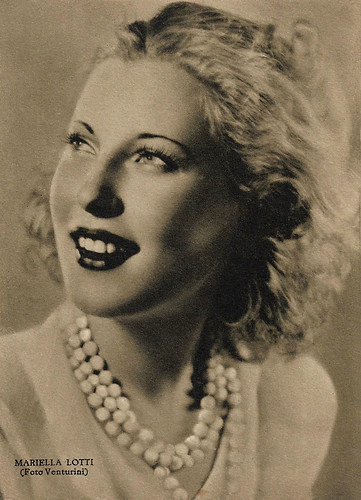
Italian postcard by Rizzoli, 1941. Photo: Venturini.

Italian postcard by Mimosa.

Romanian postcard. Amedeo Nazzari and Mariella Lotti in Quelli della montagna/Those of the Mountain (Aldo Vergano, 1943), supervised by Alessandro Blasetti.

Italian postcard by B.F.F. Edit. (Ballerini & Fratini Editori, Firenze), no. 4357. Photo: Vaselli / E.N.I.C.

Italian postcard by Ballerini & Fratini Editori, Firenze, no. 4468. Photo: Bragaglia / Lux Film. Mariella Lotti in Quelli della montagna/Those of the Mountain (Aldo Vergano, 1943).

Italian postcard by Rotalfoto, Milano / Ediz. Garami, no. 143.
Sources: Marlene Pilaete (La Collectionneuse - French), Wikipedia (Italian and English) and IMDb.

Italian postcard, no. 13.

Italian postcard by A. Terzoli, Roma, no. 420. Photo: Ghergo.

Italian postcard by Alterocca, Terni, no. 6616. Photo: Ferri. Mariella Lotti and Massimo Serato in L'Ispettore Vargas/Inspector Vargas (Gianni Franciolini, Félix Aguilera, 1940).

Italian postcard by Alterocca, Terni, no. 6619. Photo: Ferri / Generalcine. Publicity still for Il fiore sotto gli occhi/The flower under the eyes (Guido Brignone, 1944).

German postcard by Kunst und Bild, Berlin, no. A 570. Photo: Ghergo, Rome / Generalcine Film. Mariella Lotti in La donna che inventò l'amore/The Woman Who Invented Love (Ferruccio Cerio, 1952).
The Ten Commandments
Mariella Lotti was born Maria Camilla Pianotti in 1919 in Busto Arsizio, Lombardy, Italy (on 17 November 1919 according to her baptism certificate or on 18 November 1919 according to her birth certificate) Her sister Carola Lotti later also would be an actress.
In 1939, Mariella made her film debut with a small part in the comedy I figli del marchese Lucera/The sons of the Marquis Lucera (Amleto Palermi, 1939) with Armando Falconi. The following year, she played an important part in the adventure film La figlia del corsaro verde/The Daughter of the Green Pirate (Enrico Guazzoni, 1940), starring Doris Duranti, Fosco Giachetti and Camillo Pilotto.
She also played a supporting part in Il signore della tavern/The tavern ladies (Amleto Palermi, 1940). That year she also appeared in the dramas Kean (Guido Brignone, 1940) with Rossano Brazzi, and Il ponte dei sospiri/The Bridge of Sighs (Mario Bonnard, 1940) with Paola Barbara.
Two years later Lotti appeared in the drama Fari nella nebbia/Headlights in the Fog (Gianni Franciolini, 1942) starring Fosco Giachetti, Luisa Ferida and Antonio Centa. The film follows the lives of a group of truck drivers. It is considered to be part of the development of Neorealism, which emerged around this time.
Lotti then played the title role in the historical adventure film La Gorgona/The Gorgon (Guido Brignone, 1942) about the young daughter of a heroically killed nobleman in 11th Century Pisa who - as the figurehead virgin - will maintain a lantern to celebrate the men's victorious return after driving out the Saracens who are infesting the Mediterranean.
Other films of the fascist era include Quelli della montagna/Those of the Mountain (Aldo Vergano, 1943) with Amedeo Nazzari, the Opera film Silenzio, si gira!/Silence, film recording! (Carlo Campogalliani, 1943) starring Beniamino Gigli, and the war drama Squadriglia bianca (Ion Sava, 1944) with Claudio Gora.
Lotti was one of the many actors employed on the anthology film I dieci comandamenti/The Ten Commandments (Giorgio Walter Chili, 1946), made following the overthrow of Benito Mussolini. The film was shot in Rome in 1944-1945 during the Republic of Salò (when the country occupied by the Germans). At that time, all cinematic activity was transferred to Venice but many actors and technicians refused to go. This film was specifically produced to provide work for all those who decided to stay in Rome. All personnel for the film was able to obtain a work permit from the Vatican as the film, which was based on the classic Bible story, was produced by PROFIR, a Catholic production house closely linked with the catholic church. The film is now considered lost.

Italian postcard by B.F.F. Edit. (Casa Editr. Ballerini & Fratini, Firenze), no. 4365. Photo: Ghergo / Florentia Film Artisti Associati. Mariella Lotti in La Gorgona/The Gorgon (Guido Brignone, 1942).

Italian postcard by B.F.F. Edit, no. 43290. Photo: I.C.I. / Vaselli. Publicity still for Fari nella nebbia/Headlights in the fog (Gianni Franciolini, 1942).

Italian postcard by A. Scarmiglia Ed., Roma (ASER), no. 122. Photo: Fauno Film / Vaselli. Publicity still for Fari nella nebbia/Headlights in the fog (Gianni Franciolini, 1941).

Italian postcard by ASER, no. 20. Sent by mail in 1942.

Italian postcard by ENIC.
Pink Neorealism
In 1946, Mariella Lotti played a nun in the Neorealist war film Un giorno nella vita/A Day in Life (Alessandro Blasetti, 1946), about a group of partisans seeking refuge in a cloistered convent. The film was entered into the 1946 Cannes Film Festival.
She also played the female lead opposite Otello Toso and Amedeo Nazzari in the drama Malacarne/For the Love of Mariastella (1946), written and directed by Pino Mercanti. Based on a story of the Sicilian writer Giuseppe Zucca, it was mainly shot in the tonnara (tuna fisher village) of Castellammare del Golfo, with some scenes shot in the tonnaras of Scopello and of San Vito Lo Capo. It is considered as a progenitor of Pink Neorealism, the lighter genre which followed Neorealism when Italy’s conditions approved.
Lotti then co-starred with Fosco Giachetti and Andrea Checchi in the drama I fratelli Karamazoff/The Brothers Karamazov (Giacomo Gentilomo, 1947), based on the novel with the same title by Fyodor Dostoyevsky. It won two Nastro d'Argento Awards, for best screenplay and for the best score. She also starred in the historical drama Guarany (Riccardo Freda, 1948) with Antonio Vilar and Gianna Maria Canale, the Italian/American Swashbuckler I pirati di Capri/The Pirates of Capri (Edgar G. Ulmer, 1949) starring Louis Hayward, and opposite Jean Gabin in the drama È più facile che un cammello.../His Last Twelve Hours (Luigi Zampa, 1951).
In the following years, her parts became smaller. She played a supporting part in the drama Processo alla città/The City Stands Trial (Luigi Zampa, 1952) with Amedeo Nazzari. The film is based on a revisiting of the Cuocolo murders and the struggle for control of Naples by the Camorra in the early 1900s. It is considered to be director Luigi Zampa's most accomplished film and was entered into the 3rd Berlin International Film Festival.
Her final film was the Spanish-Italian drama Carmen proibita/Siempre Carmen (Giuseppe Maria Scotese, 1953) featuring Ana Esmeralda. She also acted in the theatre and worked on two stage productions with Luchino Visconti. Mariella Lotti was married to the industrialist Alfredo Zanardo. Earlier she had a well-publicised affair with Michael, Prince of Romania.
Mariella Lotti passed away in 2004 in Neuilly-Sur-Seine, France. In 2019, her hometown has celebrated the 100th anniversary of her birth and two of her grandchildren attended the event.

Italian postcard by Rizzoli, 1941. Photo: Venturini.

Italian postcard by Mimosa.

Romanian postcard. Amedeo Nazzari and Mariella Lotti in Quelli della montagna/Those of the Mountain (Aldo Vergano, 1943), supervised by Alessandro Blasetti.

Italian postcard by B.F.F. Edit. (Ballerini & Fratini Editori, Firenze), no. 4357. Photo: Vaselli / E.N.I.C.

Italian postcard by Ballerini & Fratini Editori, Firenze, no. 4468. Photo: Bragaglia / Lux Film. Mariella Lotti in Quelli della montagna/Those of the Mountain (Aldo Vergano, 1943).

Italian postcard by Rotalfoto, Milano / Ediz. Garami, no. 143.
Sources: Marlene Pilaete (La Collectionneuse - French), Wikipedia (Italian and English) and IMDb.
No comments:
Post a Comment